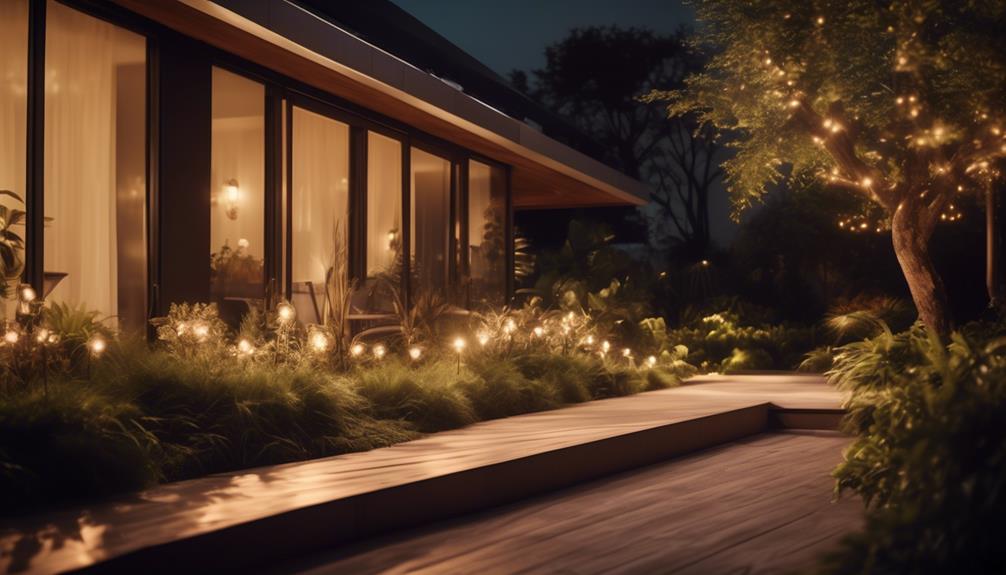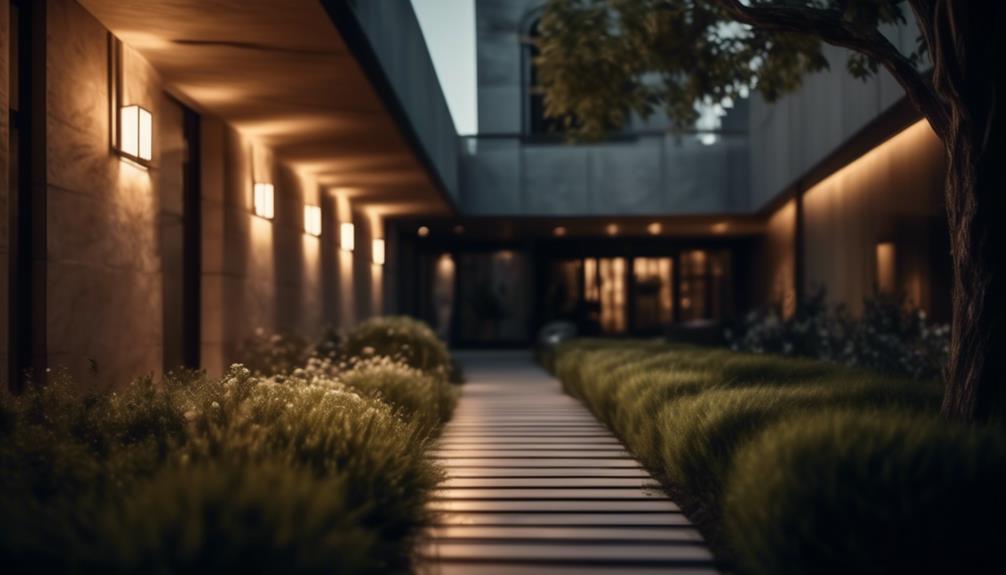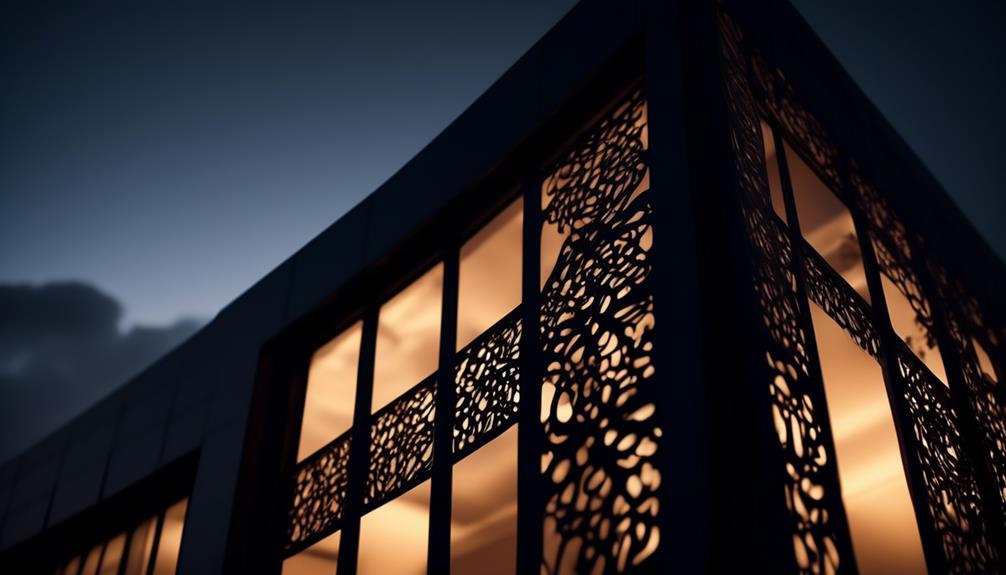You may be thinking, 'Why do I need to learn about architectural lighting techniques for outdoors?'
Well, imagine walking through a beautifully designed outdoor space at night, with strategically placed lights highlighting the architectural features and creating a warm, inviting ambiance. It can completely transform the atmosphere and enhance the overall aesthetic appeal.
In this discussion, we will explore five key techniques that professionals use to achieve stunning outdoor lighting effects.
So, if you want to elevate the look and feel of your own outdoor space, stick around to discover these game-changing techniques that will make your surroundings truly come alive.
Key Takeaways
- Uplighting is a versatile technique that enhances outdoor spaces by illuminating objects or areas from below, creating dramatic and visually striking effects.
- Downlighting adds depth and dimension to the landscape by illuminating objects and areas from above, creating interesting shadows and highlights.
- Grazing involves positioning fixtures close to a surface and casting light horizontally along the surface, creating dramatic highlights and emphasizing texture and details.
- Silhouetting adds depth and intrigue to the outdoor space by placing a light source behind an object, creating captivating shadow play and striking contrasts.
Uplighting

Uplighting is a versatile architectural lighting technique that enhances outdoor spaces by strategically placing fixtures to illuminate objects or areas from below, creating dramatic and visually striking effects. This technique is particularly effective when used to highlight trees and architectural features.
When it comes to uplighting trees, the goal is to accentuate their natural beauty and create a captivating focal point. By positioning fixtures at the base of the trees and angling the light upwards, the texture and shape of the tree's foliage are emphasized, creating an enchanting silhouette against the night sky. This technique not only adds depth and dimension to the landscape but also enhances the overall ambiance of the outdoor space.
In addition to trees, uplighting can also be used to highlight architectural features. By strategically placing fixtures at the base of buildings or structures, the unique design elements can be accentuated and showcased. The interplay of light and shadow creates a visually striking effect, drawing attention to intricate details and enhancing the overall architectural aesthetic.
Uplighting for trees and architectural features allows for creative freedom and the ability to transform outdoor spaces into captivating environments. Whether it's adding drama to a tree-lined pathway or highlighting the elegance of a building facade, uplighting offers endless possibilities for creating stunning outdoor lighting designs.
Downlighting

To further enhance your outdoor space, consider incorporating the technique of downlighting, which offers a unique and captivating way to illuminate objects and areas from above, adding depth and dimension to the landscape. Downlighting involves positioning light fixtures above the desired area, casting light downwards and creating a soft, natural glow. This technique is particularly effective for highlighting architectural features, trees, pathways, and outdoor seating areas, creating a visually appealing and inviting atmosphere.
Outdoor downlighting brings numerous benefits to your outdoor space. Not only does it provide functional lighting, but it also adds a touch of elegance and sophistication to your landscape. By casting light from above, downlighting creates interesting shadows and highlights, enhancing the visual appeal of your outdoor environment. It can also improve safety by illuminating potential hazards and ensuring clear visibility at night. Furthermore, downlighting can help create a sense of intimacy and coziness, making your outdoor space more enjoyable for gatherings and relaxation.
When installing downlighting, there are a few key tips to keep in mind. First, consider the placement and angle of the fixtures to ensure optimal lighting effects. Position the lights strategically to avoid glare and shadows. Additionally, choose fixtures that are weather-resistant and suitable for outdoor use to ensure durability and longevity. Finally, consider using dimmers or adjustable fixtures to have control over the intensity of the lighting, allowing you to create the desired ambiance for various occasions.
Incorporating downlighting into your outdoor lighting design can transform your landscape into a captivating and inviting space. By considering the benefits and following these installation tips, you can create a visually stunning outdoor environment that enhances both the aesthetic appeal and functionality of your outdoor space.
| Outdoor Downlighting Benefits | Downlighting Installation Tips |
|---|---|
| Adds depth and dimension to the landscape | Position fixtures strategically to avoid glare and shadows |
| Highlights architectural features, trees, pathways, and seating areas | Choose weather-resistant fixtures for durability |
| Creates interesting shadows and highlights | Use dimmers or adjustable fixtures for control over lighting intensity |
| Improves safety and visibility at night | Consider hiring a professional for installation if needed |
Grazing

Grazing is a lighting technique that involves positioning fixtures close to a surface and casting light horizontally along its length, creating dramatic highlights and emphasizing texture and details. This technique can be used to create stunning lighting effects in outdoor spaces, adding depth and visual interest to architectural elements. To achieve the desired dramatic effect, it's crucial to choose the right grazing fixtures for your outdoor area.
Here are some techniques to create dramatic effects using grazing:
- Position the fixtures close to the surface you want to highlight, such as a textured wall or a stone pathway.
- Use narrow beam angles to create a focused and intense beam of light that accentuates the surface.
- Experiment with different colors to add a touch of creativity and enhance the overall ambiance.
- Combine grazing with other lighting techniques, such as uplighting or downlighting, to create a layered and dynamic lighting scheme.
When choosing grazing fixtures for outdoor spaces, consider the following factors:
- Durability: Opt for fixtures that are designed to withstand harsh weather conditions.
- Waterproofing: Ensure that the fixtures have proper IP ratings to protect them from moisture.
- Beam angle: Select fixtures with adjustable beam angles to achieve the desired lighting effect.
- Energy efficiency: Look for fixtures with LED technology to minimize energy consumption and reduce maintenance costs.
Silhouetting

To create striking contrasts and add a dramatic touch to your outdoor lighting design, consider incorporating the technique of silhouetting. Silhouetting is a powerful method that involves placing a light source behind an object, such as a tree or sculpture, to create a captivating shadow play. By backlighting the subject, you can create a stunning visual effect that adds depth and intrigue to your outdoor space.
When implementing silhouetting, it's important to carefully consider the placement and angle of the light source to achieve the desired effect. Experiment with different positions and intensities to create the perfect silhouette. To enhance the shadow play, try using colored filters or gels on the light source for a more artistic and dynamic result.
Silhouetting can be particularly effective when highlighting architectural features, such as pillars or archways, as it accentuates their shape and creates a sense of mystery. It's also a great technique for showcasing natural elements like trees or bushes, adding a touch of enchantment to your landscape.
Incorporating silhouetting into your outdoor lighting design allows you the freedom to create dramatic and visually stunning effects. By carefully considering the placement and angle of the light source, as well as experimenting with different intensities and filters, you can achieve a captivating shadow play that adds depth and interest to your outdoor environment.
Path Lighting

Path lighting is an essential element in outdoor lighting design, providing both safety and aesthetic appeal to guide and enhance the pathway experience. When it comes to illuminating your paths, you have various options to choose from.
Here are some low voltage and solar powered alternatives that can elevate your outdoor space:
- Low voltage options: These lighting fixtures operate on a lower voltage than traditional lighting, making them energy-efficient and cost-effective. With options like LED path lights or bollard lights, you can create a well-lit path while reducing your energy consumption.
- Solar powered alternatives: Solar path lights harness the power of the sun to provide illumination during the night. They're self-sufficient and don't require any electrical wiring, making them a great choice for those who desire freedom from complicated installations.
- Staggered lighting: Placing path lights at staggered intervals along the pathway adds depth and visual interest. This technique ensures a consistent and even distribution of light, making your pathway more inviting and safe.
- Accent lighting: Incorporating accent lighting along the path can highlight specific features or points of interest. By strategically placing garden lights or spotlights, you can draw attention to beautiful landscaping elements or architectural details, enhancing the overall ambiance.
Choose the path lighting option that aligns with your preferences and goals. Whether you opt for low voltage fixtures or solar powered alternatives, path lighting won't only illuminate your way but also create a captivating outdoor experience.
What Are the Benefits of Using Innovative Lighting Designs for Outdoor Architectural Lighting?
Innovative lighting designs for outdoor architectural lighting can greatly enhance the ambiance and functionality of residences. These designs not only add aesthetic appeal but also increase security and safety. With the right use of innovative lighting designs, residences can create a captivating outdoor environment that is both welcoming and practical.
Frequently Asked Questions
What Are the Main Benefits of Using Uplighting in Outdoor Architectural Lighting?
What if you could enhance the beauty of your outdoor space with just the right amount of light? Uplighting, one of the key accent lighting techniques in outdoor architectural lighting, offers numerous benefits.
By illuminating structures from below, it creates stunning effects and captivating shadow play. Uplighting not only highlights the architectural features but also adds depth and dimension to your surroundings.
How Can Downlighting Contribute to Creating a Safe and Secure Outdoor Environment?
Downlighting plays a crucial role in creating a safe and secure outdoor environment. By strategically placing light fixtures overhead, it enhances visibility and prevents accidents. This technique directs light downwards, illuminating pathways, stairs, and other potential hazards, making them clearly visible to pedestrians.
Downlighting also adds a touch of elegance and artistic flair to the outdoor space, creating a welcoming ambiance while ensuring the safety of those who frequent the area.
Are There Any Specific Types of Surfaces or Materials That Are More Suitable for Grazing Lighting Techniques?
When it comes to grazing lighting techniques, certain surfaces and materials can truly shine. Whether it's brick walls, textured stucco, or even natural stone, these surfaces are ideal for creating stunning effects.
By strategically placing lights at a low angle, you can enhance the texture and depth of these materials, adding a touch of drama to your outdoor space.
However, keep in mind that grazing lighting has its limitations and may not work as effectively on smoother surfaces like glass or metal.
How Can Silhouetting Be Used to Enhance the Visual Appeal of Architectural Elements?
To enhance the visual appeal of architectural elements, you can employ silhouetting techniques. By placing a light source behind an object, you create a striking silhouette against the backdrop. This technique adds depth and drama to the architectural features, highlighting their unique shapes and contours.
Silhouetting can be particularly effective when used with structures that have interesting or intricate designs, as it accentuates their beauty and creates a captivating visual experience for the viewer.
What Are the Key Considerations When Selecting Path Lighting Fixtures for Outdoor Spaces?
When selecting path lighting fixtures for outdoor spaces, there are key considerations to keep in mind. You want to choose fixtures that will provide adequate lighting along pathways, ensuring safety and security.
Uplighting is a beneficial technique that can enhance the beauty of architectural elements, while downlighting can provide a practical and visually appealing way to illuminate walkways.








